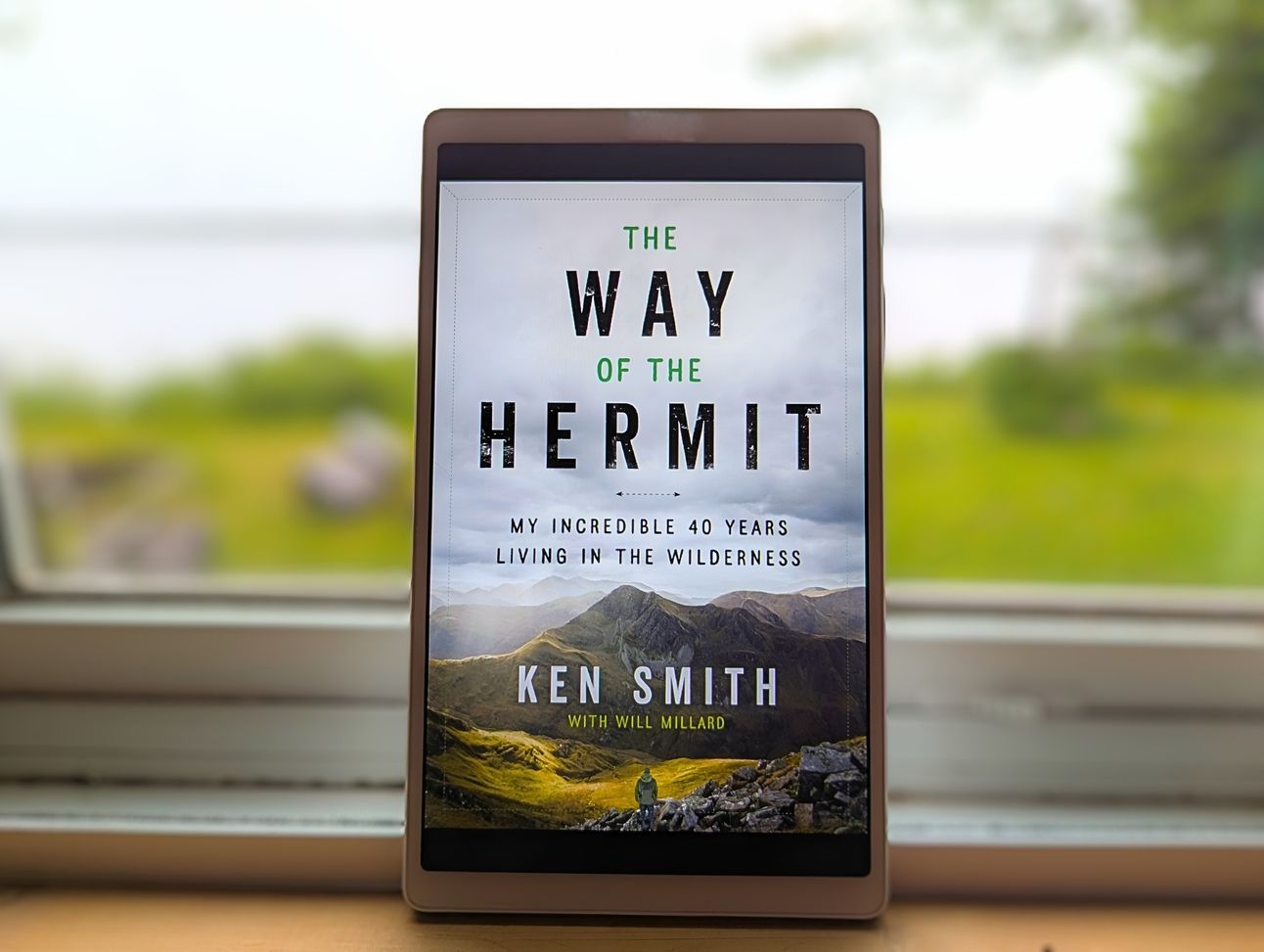A word or two before the book review:
What is a hermit? Merriam Webster offers that a hermit is “one that retires from society and lives in solitude especially for religious reasons”.
The phrasing “retires from society” seems a bit redundant to the “lives in solitude” part of the definition but it’s there for a reason. Hermits choose to separate themselves from society, to shun society’s definition of a proper way of life. They choose to do without what society has to offer. And they do so by finding a quiet place to live by themselves.
“Especially for religious reasons” means that hermits are often motivated by spiritual needs. Part of the reason for their solitude can be to allow their minds the space and freedom for spiritual contemplation. Sometimes hermits feel that their way of life is a duty, an obligation to the rest of mankind. They may see it as a way of balancing the cosmic scale or offering to others an example of how to live outside of society’s excesses. But “especially” means not always. So, sometimes hermits are just folks who appreciate their own company, and that of nature, to the company of other people. Super-introverts, in a way.
I live in the far north woods of the Upper Peninsula of Michigan (called by locals “the UP”). It’s a quiet place by nature, and the focus, even in the UP’s towns and cities, is mostly on nature. It’s the kind of place that draws nature lovers and introverts. And I can think of a handful of people I’ve known here who’ve lived like hermits for at least a part of their lives.
Reading today’s book made me think of those people, and some of the stories in the book reminded me of them, especially my great-uncle Don, who lived by himself on the same lake where my husband and I live now. He went into town mornings to visit with family and had buddies who lived on the lake that he would sometimes visit and tip a few back with, but for the most part he enjoyed his time alone with his Husky dog and later his rabbits. He may not have been quite the hermit Ken Smith is, as he had electricity and a car, but he was a solitary figure nonetheless. Hermits are there, if you just look.
So, on to the book review…
The Way of the Hermit tells the story of Ken Smith. While the title may sound like it belongs to a philosophical treatise, the book is really the autobiography of a recluse, with some practical advice for living off the grid thrown in.
It’s a well written story, told in a conversational style, and co-authored by BBC commentator Will Millard. The book chronicles the journey Ken Smith took from working class roots in the village of Whatstandwell, England to his life off the grid in a remote cottage on Loch Treig in Scotland, north of Glasgow.
In 1963, at the age of 15 Smith got his first job. It went like this - his parents got a sheepdog. With the tiny home he shared with his parents, brothers and sister, a dog was the last thing Smith thought they needed, and not something he wanted to share the tiny home with. The dog was the thing that spurred the teenager to start looking for a job that would take him away from home, and he found it in the Forestry Commission planting trees in northern Scotland. That first job embodied Smith’s love for the outdoors. From there he took a job in a nursery in Scotland planting trees before being convinced by his brother to return home and take a job in the building trades.
It was back home, in the neighboring town of Ripley where, in 1974, Smith’s life was completely upended. After a night out he was walking toward home when he was set upon by a gang of youths, shoved through the window of the local bakery and beaten senseless. He was left, he says, “in a crumpled puddle of blood and glass”.

Hermit and author Ken Smith. Co-author Will Millard holds a copy of the UK edition of the book.
Somehow, he made it home. Though he had several cuts and bruises and a headache, he believed the injuries were superficial. But the headache grew worse, and, trying to rise out of bed three days later he collapsed onto the floor, unable to move or speak. Rushed to the hospital, he lost consciousness and lay in a coma for 23 days. After four brain operations and dedicated physical therapy from the hospital nurses he eventually regained his memory, restored the ability to talk and to write, and learned to walk again. He was in the hospital for 49 days and out of work for 10 months.
Following his recovery his mother died of a heart attack. At 31, Smith decided it was time to leave it all behind, at least for a while. This time he headed to Canada. From May through early winter he and his friend Roy camped and wandered around the Canadian Rockies. He returned home only to learn that his father had passed away in his absence.
Depressed and despondent, Smith spent three and a half years working construction before he set off once again, this time alone, for the Canadian backwoods. All of his remote travel was deepening his experience as an outdoorsman and sharpening his ability to fend for himself and survive on his own in the wild. It was preparing him for his next step - finding his place in the woods of northern Scotland.
After returning home from Canada again Smith decided to strike out to find a place he could call his own in a remote area of the UK. Being familiar with the Scottish highlands from his early jobs he naturally headed in that direction.
He eventually found himself at Loch Treig, a long, narrow glacial lake, and he felt at home. He no longer felt the need to wander. “One late summer’s day”, he says, “I stood on the banks of Treig and I just knew that this was it. This was the place.”
It was here, in a small patch of woods off the lake, and after arranging a deal (and a job helping with deer hunts) with the owner of the large estate on which the woods sat, that Smith built a cabin and settled down. Nine miles from the nearest neighbor and completely off the grid, he made his home.
The rest of the story is full of Smith’s advice on building a cabin by hand, on creating a garden and setting it up to sustain a person (though he does not wholly depend on his garden), and on all the various plants he’s managed to make “wine” from.
By the book’s end Smith is in his 70s struggling with health issues and again in need of hospital stays, this time from a battle with cancer, from which he recovers.
Throughout his life Smith has kept journals and taken photos to chronicle his life. He draws on these to tell his story. In the early 2020’s he somehow came to the attention of a Lizzie McKenzie, who put together a documentary film about him that aired on BBC Scotland. From there this book was born. Originally published last year in the UK, the book is now available in the States.
There’s enough left out that one wonders. Why was he set upon by that gang? Why was his reaction to run away from everything? Why are the snippets of writing from his diary so different than the writing style of the book - how much is his and how much Millard’s? But it’s a good read and an interesting life story, and whether such questions matter is really up to each reader to decide for themselves.
RATING: Four Stars ⭐⭐⭐⭐
RATING COMMENTS: An easy to read and interesting biography of a working-class man whose life took a turn after a nasty incident, and who became a hermit.
WHERE I GOT MY COPY: I read an advanced review copy provided through NetGalley and Harlequin Trade Publishing, the book’s publisher.
See What Others Think
Washington Post: What one man learned living alone in the wilderness for 40 years
Slate Magazine: Alone and Unafraid
The Scotsman: Book review: The Way Of The Hermit, by Ken Smith with Will Millard: This is a book that leaves you with more questions than answers, writes Stuart Kelly
Title: The Way of the Hermit
Author: Ken Smith with Will Millard
Publisher: Harlequin Trade Publishing (an imprint of Harper Collins Publishers, a News Corp company)
Publish Date: May 28, 2024
ISBN-13: 9781335454966
Publisher’s List Price: $20.99 (US paperback. Price as of July 03 2024.)


